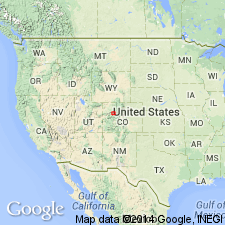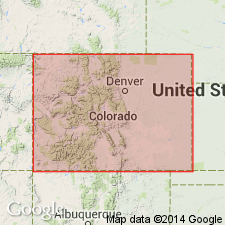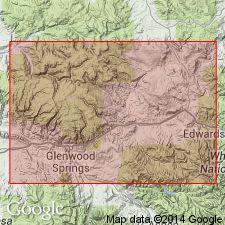
- Usage in publication:
-
- Clinetop algal limestone member*
- Modifications:
-
- Original reference
- Dominant lithology:
-
- Limestone
- Conglomerate
- AAPG geologic province:
-
- Piceance basin
Summary:
Named Clinetop algal limestone member, upper member of the Dotsero formation (Upper Cambrian). Is an algal limestone that forms a conspicuous ledge. Described as a coarse, flat-pebble limestone, brown and gray, algal or stromatolitic conglomerate containing abundant glauconite, and a crystalline to dense algal (of the genus CRYPTOZOON and COLLENIA) limestone with crinkly to wavy structure. Is 5 feet thick at its type where it overlies Glenwood Canyon member (new) of Dotsero and underlies Dead Horse conglomerate member (new) of Manitou formation. Ranges from 3 to 5 feet thick. Recognized to east on Grizzly Creek, to west on Main Elk Creek, and to north on South Fork. Is thickest (10 feet) in eastern Glenwood Canyon. Age is Late Cambrian. Is an algal biostrome that indicates quiet water environment. Report includes measured sections, cross section.
Type locality: well-exposed in NE/4 sec. 35, T. 3 S., R. 90 W., and in SW/4 sec. 23, T. 3 S., R. 90 W., near Sixmile Lake, [Garfield Co., CO]. Named for exposures in the Clinetop country (in T. 3 and 4 S., R. 90 W.), Garfield Co., CO, in the Piceance basin.
Source: Modified from GNU records (USGS DDS-6; Denver GNULEX).

- Usage in publication:
-
- Clinetop Member
- Modifications:
-
- Revised
- AAPG geologic province:
-
- Piceance basin
Summary:
Name Horseshoe Mountain Group applied to rocks of the Sauk sequence in central CO of Late Cambrian and Early Ordovician age. In its northwest province near Glenwood Springs, Garfield Co in the Piceance basin, the group is divided into the Sawatch Sandstone, Dotsero Formation (and its Glenwood Canyon and Clinetop Members), and Manitou Limestone (and its Deadhorse and Tie Gulch Members). In its southeast province--near Salida, Gunnison Co in the Piceance basin, Colorado Springs, El Paso CO in the Denver basin, and Fairplay, Park Co in the South Park basin--the group is divided into the Sawatch Sandstone, Peerless Formation, and Manitou Limestone (and its Helena Canyon, Ptarmigan (provisional), and Fairplay (provisional) Members). The group is named for exposures on Horseshoe Mountain (the type section) near Fairplay in Park Co. Rocks of the group include conglomerate, sandstone, shale, limestone, and dolomite. Correlation chart. Thickness of group at type (southeast facies--sec 12, T10S, R79W) is 352 ft: Manitou, 167 ft; Peerless, 35 ft; and Sawatch, 150 ft. Thickness of group in northwest facies (sec 15, T5S, R87W) is 772 ft: Manitou, 156 ft; Dotsero, 96 ft; and Sawatch, 520 ft.
Source: GNU records (USGS DDS-6; Denver GNULEX).

- Usage in publication:
-
- Clinetop Member*
- Modifications:
-
- Redescribed
- Areal extent
- Dominant lithology:
-
- Conglomerate
- Limestone
- AAPG geologic province:
-
- Piceance basin
- Eagle basin
Summary:
Name modified from Clinetop Algal Limestone Member to Clinetop Member, upper member of Dotsero Formation (Upper Cambrian). Overlies Glenwood Canyon Member of Dotsero. Occurs over an area of 1,500 to 2,600 sq km in eastern Garfield and Rio Blanco Counties, Colorado, Piceance basin, and western Eagle County, Colorado, Eagle basin. Deposited in a belt 24 to 32 km wide and 64 to 80 km long. Divided into three units. (1) the basal conglomerate unit is a flat-pebble, gray, red-purple, limestone conglomerate 3 to 43 cm thick in a gray fossiliferous microcrystalline limestone matrix. The pebbles range from 1 to 5 cm and they make up 10 to 35 percent of the rock. The matrix is 16 to 37 percent fossil fragments (predominantly trilobites and echinoderms). (2) the stromatolitic algal-head unit is 8 to 91.4 cm thick. It forms a gray-white ledge. The algal heads are of CRYPTOZOON (base) and COLLENIA (top); they are of fine-grained, dense, laminated limestone. Numerous channels cut the upper surface of the algal head unit. (3) the upper conglomeratic unit is a flat-pebble carbonate conglomerate with a bioclastic matrix that ranges from 1.6 to 21 cm thick. The pebbles in the upper unit are scattered and range from 3 to 15 cm. The matrix of the upper unit is coarse sand. Clinetop was deposited in the intertidal and supratidal zones of a shallow sea regressing to the southwest. Report includes isopach map.
Source: Modified from GNU records (USGS DDS-6; Denver GNULEX).
For more information, please contact Nancy Stamm, Geologic Names Committee Secretary.
Asterisk (*) indicates published by U.S. Geological Survey authors.
"No current usage" (†) implies that a name has been abandoned or has fallen into disuse. Former usage and, if known, replacement name given in parentheses ( ).
Slash (/) indicates name conflicts with nomenclatural guidelines (CSN, 1933; ACSN, 1961, 1970; NACSN, 1983, 2005, 2021). May be explained within brackets ([ ]).

